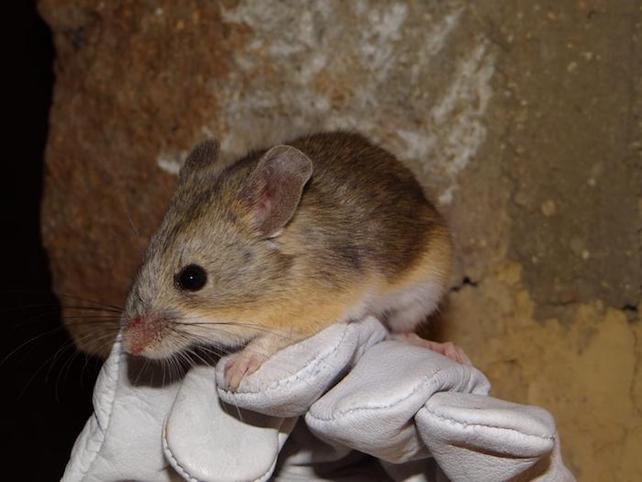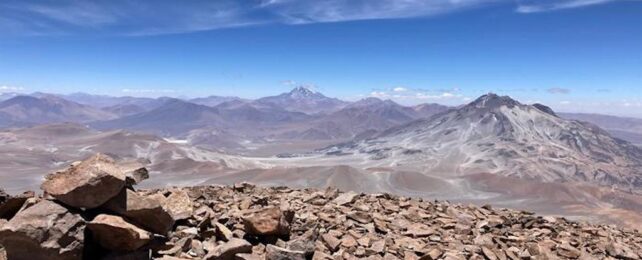Not much lives in the Puna de Atacama, a frigid moonscape high in the Andes with violent winds, meager oxygen, and virtually no water.
For some reason, though, mountaineering mice keep venturing to the summits of 6,000-meter (20,000-foot) volcanoes in this high desert plateau and surviving up there.
At first, archaeologists exploring the peaks in the 1970s and '80s found carcasses of the Punta de Vacas leaf-eared mice (Phyllotis vaccarum), which had mummified in the extreme conditions.
Reasoning the mice couldn't have made it there on their own, the archaeologists assumed they must have been brought up the mountains by ancient Inca people, who are known to have made long-distance pilgrimages to mountaintops they considered sacred.
Those pilgrimages were part of a ceremony known as Capacocha, which involved the ritual sacrifice of children and animals to Incan gods. The mice could have stowed away in supplies, the archaeologists figured, or may have been brought intentionally as sacrificial offerings.
"You can't fault the archaeologists for thinking this way, because what other explanation is there?" says co-author Jay Storz, an evolutionary biologist at the University of Nebraska-Lincoln. "Nothing could be living up there, so they had to have been brought there."
After Storz and his colleagues happened across a mouse mummy atop Volcán Salín, they began a systematic search there and on other local peaks. They've searched 21 volcanic summits so far, they report, and found 13 mouse remains on several taller than 6,000 meters.
"These are basically freeze-dried, mummified mice," Storz says.
On top of that, Storz and a colleague also captured a live leaf-eared mouse in 2020 on the peak of Llullaillaco, a 6,700-meter-high volcano near the border between Chile and Argentina, raising new questions about the origins of all those mummies.
It was the first time any mammal had been found living at such a high altitude, the researchers note, but it wouldn't be the last. They ended up capturing more live specimens on these peaks, and conducting tests on some of the mummies to shed light on their backstories.
Analysis suggests eight mouse mummies from Salín and one from Copiapó died within the last several decades, likely sometime after 1955, the study's authors report.
Four mummies from Púlar could be older, having died up to 350 years ago, but that was still a century after Spanish invaders brought down the Inca Empire.
"It now seems more and more clear that the mice got there of their own accord," Storz says.
Mummification helped preserve DNA within the dead mice, Storz and his colleagues note, allowing the researchers to analyze genetic variation among mice found at various elevations in the Atacama Desert, providing insight on their evolutionary history.
The researchers were curious if the genomes of mountaintop mice would show they comprised a distinct subpopulation, having diverged from known populations of leaf-eared mice at lower elevations.
"Our genomic data indicate no: that the mice from the summits, and those from the flanks or the base of the volcanoes in the surrounding desert terrain, are all one big happy family," Storz says.
Two pairs of mouse mummies were closely related, the study found, suggesting they were either siblings or parents with offspring.

Along with other clues – like the equal ratio of male and female mummies, plus the presence of live mice and mouse burrows – the researchers say the evidence indicates these mice are not tourists, but residents who found a way to survive in this Mars-like environment.
The Puna de Atacama is so Mars-like that NASA has visited the plateau to simulate the conditions on the red planet, the researchers note.
"Even at the base of the volcanoes, the mice are living in an extreme, Martian environment. And then, on the summits of the volcanoes, it's even more so. It feels like outer space," Storz says.
"It just boggles the mind that any kind of animal, let alone a warm-blooded mammal, could be surviving and functioning in that environment," he adds. "When you experience it all firsthand, it even further impresses upon you: How in God's name is anything living up there?"
Researchers are still trying to answer that question, collecting leaf-eared mice from various elevations to establish captive colonies, then acclimating those colonies to various elevations in hopes of revealing any relevant adaptations for mountain top living.
They're also still trying to understand not just how, but why the mice are living up there. They could be fleeing predators at lower elevations, for example, but would that safety really be worth the dangers of freezing, starving, and dehydration?
"Certainly, if you're hunkering down on top of a 6,000-meter volcano, you're at least safe from [predators]," Storz says. "You just have other things to worry about."
The study was published in Current Biology.
